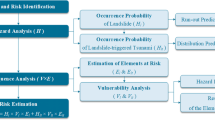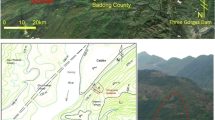Abstract
The Three Gorges Reservoir, which is located in an area with a high incidence of geological hazards, has recently suffered great losses owing to landslide-induced impulse waves. Along with the rapid development of cities in the vicinity of the Yangtze River, the Three Gorges Reservoir, with current daily traffic of about 235 large vessels, is an increasingly important logistics channel. The risk related to impulse waves in this channel cannot be ignored. In this study, a combined quantitative-qualitative technical framework is proposed to assess the risk of landslide-induced impulse waves in the Three Gorges Reservoir based on a combination of risk assessment methods for landslides and tsunamis. The proposed assessment method is applied to the Wu Gorge section of the reservoir, which is prone to landslides and consequent impulse waves. A risk analysis is performed on landslides known-to-date to be of potential threat to the Wu Gorge through tsunami genesis, including the Maocaopo landslide, Gongjiafang IV landslide, Ganjingzi landslide, Jianchuandong rockfall, Quchitan rockfall, and Banbiyan rockfall. As communities along the Yangtze River are more likely to be exposed to impulse waves when there is a high water level of 175 m above sea level, there are significant differences for areas affected by impulse waves under different water level conditions. The vulnerability of both sailing and moored ships is analyzed by a simple quantitative method, while a vulnerability assessment for riverside communities is performed qualitatively. Based on the results of the risk assessment, the potential landslides can be ranked from high to low level of risk as Jianchuandong rockfall, Banbiyan rockfall, Quchitan rockfall, Gongjiafang IV landslide, Maocaopo landslide, and Ganjingzi landslide. The impulse waves caused by the Jianchuandong rockfall could cause the highest level of human loss, as the Qingshi community will be attacked by it, while the Ganjingzi landslide could cause the highest economic loss (about 8 million RMB or 1.16 million USD), as many wharf boats and vessels docked in the wharf of Wushan County will be attacked by it. The Qingshi and Peishi communities have fallen into the very high-risk rank. The proposed method for risk analysis may provide a basis for the risk priority control of geological hazards and early warning in the Wu Gorge section. However, there is still a long journey before a mature technical framework for risk assessment on landslide-induced impulse waves in reservoirs can be achieved. The methods presented here can help to control, prevent, and reduce the destructive consequences of landslide-induced waves in reservoirs around the world.





Similar content being viewed by others
References
Arrow KJ (1971) Insurance, Risk and Resource Allocation Essays in the Theory of Risk-Bearing, pp 134–143
Ataie-Ashtiani B, Najafi-Jilani A (2008) Laboratory investigations on impulsive waves caused by underwater landslide. Coast Eng 55:989–1004
Ataie-Ashtiani B, Shobeyri G (2008) Numerical simulation of landslide impulsive waves by incompressible smoothed particle hydrodynamics. Int J Numer Methods Fluids 56:209–232
Ataie-Ashtiani B, Yavari-Ramshe (2011) Numerical simulation of wave generated by landslide incidents in dam reservoirs. Landslides 8(4):417–432
Australian Geomechanics Society (2000) Landslide Risk Management Concepts and Guidelines. Aust Geomech 5(1):49–92
Barberopoulou A, Mark RL, Burak U, Costas ES (2011) Reassessing the tsunami risk in major ports and harbors of California I: San Diego. Nat Hazards 58:479–496
Baum RL, Coe JA, Godt JW et al (2005) Regional landslide-hazard assessment for Seattle, Washington, USA. Landslides 4:266–279
Birkmann J (2006) Measuring vulnerability to natural hazards: towards disaster resilient societies. United Nations University Press, New York
Birkmann J, Von TK, Welle T et al (2010) The unperceived risk to Europe’s coasts: tsunamis and the vulnerability of Cadiz, Spain. Nat Hazards Earth Syst Sci 10:2659–2675
Charalampakis M, Stefatos A, Mpourdopoulos K, Ferentinos G (2007) Towards the mitigation of the tsunami risk by submarine mass failures in the gulf of Corinth: the xylocastro resort town case study. Submarine Mass Movements and Their Consequences, pp 367–375
Chen L, Yang QF, Yu T et al (2017) Model experimental studies of safety of moored ship under landslide surge action. Hydro-Sci Eng 1:80–86 (in Chinese)
Clague JJ, Munro A, Murty T (2003) Tsunami hazard and risk in Canada. Nat Hazards 28(2–3):433–461
Crichton D (1999) The risk triangle. In: Ingleton J (ed) Natural Disaster Management. Tudor Rose, London, pp 102–103
De Girolamo P, Di Risio M, Romano A, Molfetta MG (2014) Landslide tsunami: physical modeling for the implementation of tsunami EarlyWarning Systems in the Mediterranean Sea. Procedia Engineering 70:429–438
Di Risio M, Sammarco P (2008) Analytical modeling of landslidegenerated impulse waves. J Waterw Port Coast Ocean Eng 134:53–60
Di Risio M, Bruschi A, Lisi I, Pesarino V, Pasquali D (2017) Comparative analysis of coastal flooding vulnerability and Hazard assessment at National Scale. J Mar Sci Eng 5:51–69
Fell R (1994) Landslide risk assessment and acceptable risk. Can Geotech J 31(2):261–272
Fournier DEM (1979) Objectives of volcanic monitoring and prediction. J Geol Soc 136:321–326
Fritz HM, Hager WH, Minor HE (2004) Near field characteristics of landslide generated impulse waves. ASCE J Waterw Port Coast Ocean Eng 130:287–302
Galli M, Guzzetti F (2007) Landslide vulnerability criteria: a case study from Umbria, Central Italy. Environ Manag 40:649–664
Geological Team of ChongQing City (2016) Geo-hazard survey in Yangtze River main stream of Three Gorges Reservoir of Chongqing City. Report of Land & Resources Department of ChongQing City, 2016, Chongqing
Gornitz VM, Daniels RC, White TW, Birdwell KR (1994) The development of a coastal risk assessment database: vulnerability to sea-level rise in the US southeast. J Coast Res 327-338
Granger K, Jones T, Leiba M, Scott G (1999) Community risk in Cairns: a multi-hazard risk assessment. Australian Geological Survey Organization, Canberra
Grezio A, Gasparini P, Marzocchi W, Patera A (2012) Tsunami risk assessments in Messina, Sicily – Italy. Nat Hazards Earth Syst Sci 12(1):151–163
Guo XiY, Wu D, Luo Y (2017) The freight volume via Three Gorges ship lock reached a record of 1.3 million tons in 2016, which is the highest record of history. http://www.chinanews.com/cj/2017/01-06/8116159.shtml. (in Chinese). Accessed 4 Sept 2017
Hiroaki S, Hitoshi M, Yasunori K, Naoaki Y (2003) Study on a simplified method of tsunami risk assessment. Nat Hazards 29:325–340
Ho KKS, Leroi E, Roberds B (2000) Quantitative risk assessment-application, myths and future direction. Proc. of the international conference on geotechnical and geological engineering. Melbourne 1:269–312
Huang BL, Chen LD, Peng XM et al (2010) Assessment of the risk of rockfalls in Wu gorge, three gorges, China. Landslides 7(1):1–11
Huang BL, Yin YP, Liu GN, Wang S, Chen X, Huo Z (2012) Analysis of waves generated by Gongjiafang landslide in Wu gorge, three gorges reservoir, on November 23, 2008. Landslides 9(3):395–405
Huang BL, Liu GN, Wang SC, Chen XT, Qi X (2015) Disaster mechanism study on high-steep Bank of Three Gorges Rerservoir. Science Press, Beijing (in Chinese)
Huang BL, Yin YP, Du C (2016) Risk management study on impulse waves generated by Hongyanzi landslide in three gorges reservoir of China on June 24, 2015. Landslides 13(3):603–616
Huber A, Hager WH (1997) Forecasting impulse waves in reservoirs. In: Dixneuvie’me congress des grands barrages C, Florence, Italy, vol 31. Commission International des Grands Barrages, Paris, pp 993–1005
Hungr O, Leroueil S, Picarelli L (2014) The Varnes classification of landslide types, an update. Landslides 11(2):167–194
Jelinek R, Krausmann E, Gonzalez M, Alvarez-Gomez JA, Birkmann J, Welle T (2012) Approaches for tsunami risk assessment and application to the city of Cadiz, Spain. Nat Hazards 60:273–293
Lee KH, Kim SW, Kim SH (2016) Simulating floods triggered by volcanic activities in the Cheon-ji caldera lake for hazards and risk analysis. J Flood Risk Manag 11:S479–S488. https://doi.org/10.1111/jfr3.12245
Lu D, Wang PY, Yu T et al (2014) Experimental studies of restricted waterway for ships during landslide generated waves. Hydro-Sci Eng 4:70–77 (in Chinese)
Martínez-Graña A, Boski T, Goy J, Zazo C, Dabrio C (2016) Coastal-flood risk management in Central Algarve:vulnerability and flood risk indices (South Portugal). Ecol Indic 71:302–316
Oppenheimer D, Rhoades JM, Roberts C, Von Hillebrandt-Andrade, Whitmore P, Williams C (2009) National Tsunami Hazard Mitigation Program 2009–2013 Strategic Plan. U.S. NTHMP, Silver Spring, p 34
Rynn J, Davidson J (1999) Contemporary assessment of tsunami risk and implication for early warnings for Australia and its island territories. Sci Tsunami Hazards 17(2):107–125
Sergio F, Chrisroph A, Stephanie W (2013) Advaning tsunami risk assessment by impr oving spatio-temporal population exposure and evacuation medeling. Nat Hazards 68:1311–1324
Strunz G, Post J, Zosseder K et al (2011) Tsunami risk assessment in Indonesia. Nat Hazards Earth Syst Sci 11:37–82
The Command of the Geo-hazard Prevention and Control Work for the Three Gorges Reservoir Area (2014) Technical requirements for geological exploration for geological Hazard control projects in the three gorges reservoir region. China University of Geosciences Press CO., LTD, Wuhan
The State Oceanic Administration of PRC (2015) Emergency Plan for Storm Surge, Sea Wave, Tsunami, and Sea Ice Disasters. http://www.china.com.cn/haiyang/2014-07/15/content_32953307.htm (in Chinese). Accessed 4 Sept 2017
Thieler E, Hammar-Klose E (1999) National Assessment of coastal vulnerability to Future Sea level rise: preliminary results for the U.S. Atlantic Coast; technical report open-file report 99-593; U.S. Geological Survey: Reston, VA, USA
Thywissen K (2006) Core terminology of disaster reduction: a comparative glossary. In: Birkmann J (ed) Measuring vulnerability to natural hazards. UNU Press, Tokyo, pp 448–496
Van Westen CJ, Asch TWJ, Soeters R (2005) Landslide hazard and risk zonation-why is it still so difficult? Bull Eng Geol Environ 65(2):167–184
Walder JS, Watts P, Oscar ES, Kenneth J (2003) Water waves generated by subaerial mass flows. J Geophys Res 108:2236–2255
Wang SC, Huang BL, Liu GN (2015) Numerical simulation of tsunami due to slope failure at Gongjiafang on three gorges reservoir. Chin J Rock Soil Mech 36(01):212–218
Watts P, Grilli ST, Kirby JT, Fryer GJ, Tappin DR (2005) Landslide tsunami case studies using a Boussinesq model and a fully nonlinear tsunami generation model. Nat Hazards Earth Syst Sci 3:391–402
Wu SR (2012) Theory and Technology of Landslide Risk Assessment. Science Press, Beijing
Wu SR, Shi JS, Zhang CS, Wang T (2009) Preliminary discussion on technical guideline for geohazard risk assessment. Geol Bull China 2009(8):995–1005 (In Chinese)
Xiang XQ, Huang RQ (2000) Risk assessment and risk management for slope geohazards. Chin J Geol Hazards Environ Preserv 1:38–41 (In Chinese)
Xie JS, Ioan N, Tad M (2012) Tsunami risk for Western Canada and numerical modelling of the Cascadia fault tsunami. Nat Hazards 60:149–159
Yanagisawa H, Koshimura S, Miyagi T et al (2010) Tsunami damage reduction performance of a mangrove forest in Banda Aceh, Indonesia inferred from field data and a numerical model. J Geophys Res Oceans 115(C6):1–11
Yin K, Liu Y, Wang Y, Jiang Z (2012) Physical model experiments of landslide-induced surge in three gorges reservoir. Earth Sci J China Univ Geosci 37(5):1067–1074
Yin YP, Huang BL, Liu GN, Wang S (2015) Potential risk analysis on a Jianchuandong dangerous rockmass - generated impulse wave in the three gorges reservoir, China. Environ Earth Sci 74:2595–2607
Yin YP, Huang BL, Wang WP, Wei YJ, Ma XH, Ma F, Zhao CJ (2016) Reservoir-induced landslides and risk control in three gorges project on Yangtze River, China. J Rock Mech Geotech Eng 8:577–595
Zeynep CC, Mehmet LS, Ahmet CY, Cagil K, Andrey Z, Betul A (2016) A New GIS-based tsunami risk evaluation: MeTHuHVA (METU tsunami human vulnerability assessment) at Yenikapl, Istanbul. Earth Planets Space 68:133–154
Zhang ZH, Huang BL, Wang P (2017) Geo-hazard survey report of Banbiyan Rockfall, report of Land & Resources Department of ChongQing City, 2016, Chongqing (in Chinese)
Acknowledgements
The authors appreciate the anonymous reviewers of this paper and Barberopoulou Aggeliki for their detailed remarks and helpful suggestions. Meanwhile, the authors acknowledge Vikas Narang who helped us polish our English writing.
Funding
This work was supported by the National Key R&D Program of China (ID 2018YFC1504803), National Natural Science Foundation of China (ID 41372321) and China Geological Survey Project (121201009000150018).
Author information
Authors and Affiliations
Corresponding author
Rights and permissions
About this article
Cite this article
Huang, B., Yin, Y. & Tan, J. Risk assessment for landslide-induced impulse waves in the Three Gorges Reservoir, China. Landslides 16, 585–596 (2019). https://doi.org/10.1007/s10346-018-1115-9
Received:
Accepted:
Published:
Issue Date:
DOI: https://doi.org/10.1007/s10346-018-1115-9




